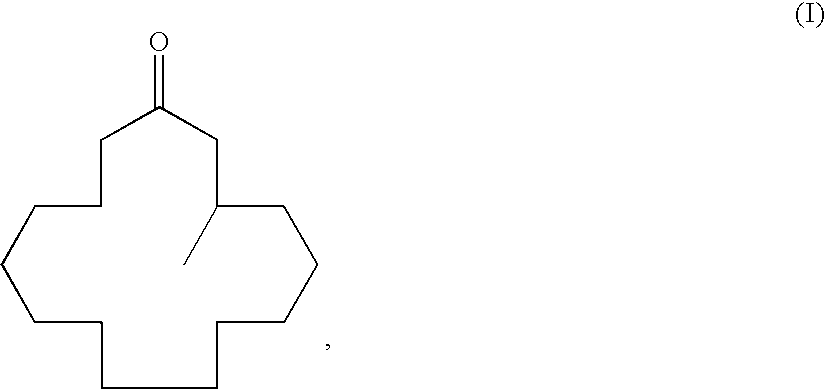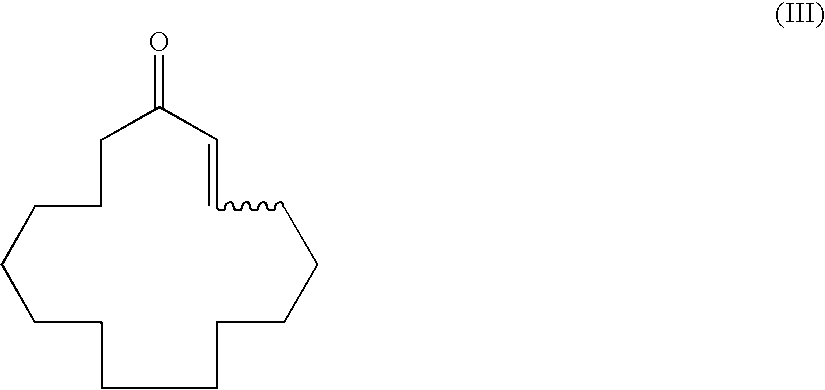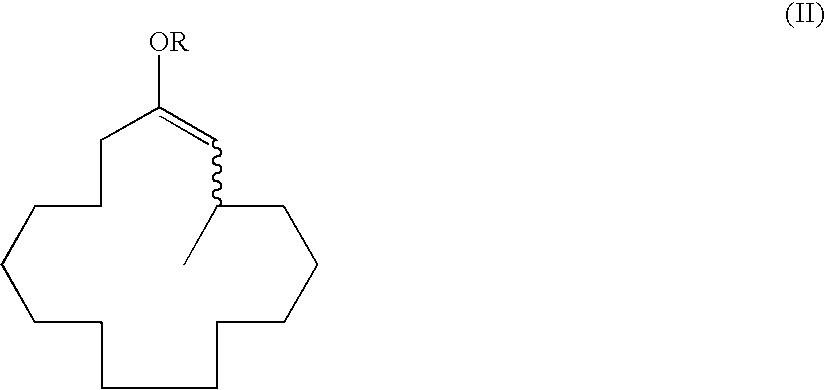Method of producing macrocyclic ketone, and intermediate thereof
a macrocyclic ketone and muscone technology, applied in the field of macrocyclic ketone muscone production, can solve the problems of unsatisfactory, poor yield of objective product, and reported method of producing ()-(r)-muscone by using a chiral auxiliary group that is yet to be commercialized, and achieves high concentration and high yield
- Summary
- Abstract
- Description
- Claims
- Application Information
AI Technical Summary
Benefits of technology
Problems solved by technology
Method used
Image
Examples
example 1
Synthesis of (R)-3-methyl-1-cyclopentadecenyl propionate
[0130]To a 1,000 ml reaction flask 1.32 g (2.9 mmol) of an optically active ligand 4-(cis-2,6-dimethylpiperidine)-(R)-ditetra-hydronaphthodioxaphosphepin, 0.47 g (1.3 mmol) of Cu(OTf)2, 115 ml (230 mmol) of a dimethylzinc toluene solution (2.0 mol / L), and 524 g of xylene were added and cooled to −20° C. under a nitrogen atmosphere. Then, 20.6 g (158 mmol) of propionic anhydride and 32 g (144 mmol) of (2E)-cyclopentadecenone were added thereto dropwise over 3 hours. After dropwise addition, the mixture was stirred for 4 hours until completion of the reaction was determined by gas chromatographic analysis. The reaction was terminated by addition of an aqueous 5% sulfuric acid solution after completion of the reaction; the reaction solution was phase-separated and washed with water; and then, the solvent was evaporated under reduced pressure to give 43.2 g of a crude product. The concentrated solution was distilled (boiling point:...
example 2
Synthesis of (R)-muscone
[0135]To a 200-ml round-bottomed flask 27.3 g (93 mmol) of (R)-3-methyl-1-cyclopentadecenylpropionate obtained in Example 1 and 54.6 g of toluene were added and stirred. 17.9 g (93 mmol) of a methanolic 28% sodium methoxide solution was added dropwise at 20° C., and the mixture was stirred additionally for 1 hour until completion of the reaction was determined by gas chromatographic analysis. The reaction was terminated by addition of an aqueous 5% sulfuric acid solution after completion of the reaction; the reaction solution was phase-separated and washed with water; and then, the solvent was evaporated under reduced pressure to give 29.4 g of crude (R)-muscone. The concentrated solution was distilled (boiling point: 110° C. / 50.5 Pa) to give 21.4 g (90 mmol) of the title compound (yield: 97%). The optical purity thereof as determined by high-performance liquid chromatography was 83% ee.
example 3
Synthesis of (R)-3-methyl-1-cyclopentadecenyl acetate
[0136]Under a nitrogen atmosphere 3.30 g (7.25 mmol) of an optically active ligand 4-(cis-2,6-dimethylpiperidine)-(R) -ditetrahydronaphthodioxaphosphepin, 1.31 g (3.62 mmol) of Cu(OTf)2, 217 ml (0.43 mol) of a dimethylzinc toluene solution (2.0 mol / l), and 1420 g of toluene were added to a 2,000-ml reaction flask and stirred. Then, 37.0 g (0.36 mol) of acetic anhydride was added thereto at −20° C., and then 79.8 g (0.36 mol) of (2E)-cyclopentadecenone was added thereto dropwise over 1 hour. After dropwise addition, the mixture was stirred for 6 hours until completion of the reaction was determined by gas chromatographic analysis. The reaction was terminated by addition of an aqueous 5% sulfuric acid solution after completion of the reaction; the reaction solution was phase-separated and washed with water; and then, the solvent was evaporated under reduced pressure to give 152 g of a crude product. The concentrated solution was dis...
PUM
| Property | Measurement | Unit |
|---|---|---|
| temperature | aaaaa | aaaaa |
| temperature | aaaaa | aaaaa |
| temperature | aaaaa | aaaaa |
Abstract
Description
Claims
Application Information
 Login to View More
Login to View More - R&D
- Intellectual Property
- Life Sciences
- Materials
- Tech Scout
- Unparalleled Data Quality
- Higher Quality Content
- 60% Fewer Hallucinations
Browse by: Latest US Patents, China's latest patents, Technical Efficacy Thesaurus, Application Domain, Technology Topic, Popular Technical Reports.
© 2025 PatSnap. All rights reserved.Legal|Privacy policy|Modern Slavery Act Transparency Statement|Sitemap|About US| Contact US: help@patsnap.com



